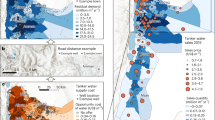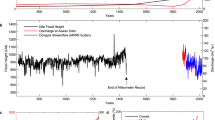Abstract
Los Angeles imports water over long distances to supplement local supplies. Reduced reliability of the available imports is driving many local agencies to promote conservation and enhance local water sources. These include stormwater capture, water reuse and groundwater. But financial considerations are often a significant impediment to project development, especially when comparing new and existing sources. Here we demonstrate a comprehensive approach for evaluating the economic implications of shifting to local water reliance in Los Angeles County. We show that local water supplies are economically competitive. Results from integrated hydroeconomic modelling of urban water in Los Angeles identify cost-effective water supply portfolios and conservation targets. Considering costs across the ‘full-cycles’ of urban water supply that span agency boundaries yields better comparisons of planning alternatives. Throughout the region, many water retailers could successfully mitigate effects of imported water cuts while still supporting drought-tolerant landscapes, but some would suffer due to over-reliance on imports. Updating economic assessment methods would support needed innovations to achieve local reliance in Los Angeles, including infrastructure investments, institutional reforms, many more drought-tolerant landscapes and reallocated groundwater rights.
This is a preview of subscription content, access via your institution
Access options
Access Nature and 54 other Nature Portfolio journals
Get Nature+, our best-value online-access subscription
$29.99 / 30 days
cancel any time
Subscribe to this journal
Receive 12 digital issues and online access to articles
$119.00 per year
only $9.92 per issue
Buy this article
- Purchase on Springer Link
- Instant access to full article PDF
Prices may be subject to local taxes which are calculated during checkout


Similar content being viewed by others
References
Niemczynowicz, J. Urban hydrology and water management-present and future challenges. Urban Water 1, 1–14 (1999).
Hering, J. G., Waite, T. D., Luthy, R. G., Drewes, J. E. & Sedlak, D. L. A changing framework for urban water systems. Environ. Sci. Technol. 47, 10721–10726 (2013).
Hellström, D., Jeppsson, U. & Kärrman, E. A framework for systems analysis of sustainable urban water management. Environ. Impact Assess. Rev. 20, 311–321 (2000).
Ackermann, W. C., Geyer, J. C., Izzard, C. F., Jens, S. W. & Jones, D. E. Systematic Study and Development of Long-range Programs of Urban Water Resources Research (Clearinghouse, 1968).
Pincetl, S., Porse, E. & Cheng, D. Fragmented flows: water supply in Los Angeles County.Environ. Manag. 58, 208–222 (2016).
Ostrom, V. The water economy and its organization. Nat. Resour. J. 2, 55 (1962).
Mini, C., Hogue, T. S. & Pincetl, S. Estimation of residential outdoor water use in Los Angeles, California. Landsc. Urban Plan. 127, 124–135 (2014).
Hanak, E. & Davis, M. Lawns and Water Demand in California (Public Policy Institute of California, San Francisco, CA, 2006).
Pataki, D. E., McCarthy, H. R., Litvak, E. & Pincetl, S. Transpiration of urban forests in the Los Angeles metropolitan area. Ecol. Appl. 21, 661–677 (2011).
Litvak, E., Manago, K., Hogue, T. S. & Pataki, D. E. Evapotranspiration of urban landscapes in Los Angeles, California at the municipal scale. Water Resour. Res. 53, 4236–4252 (2017).
McDonald, R. I. et al. Water on an urban planet: urbanization and the reach of urban water infrastructure. Glob. Environ. Change 27, 96–105 (2014).
Porse, E. Artes: A Model of Urban Water Resources Management in Los Angeles (UCLA California Center for Sustainable Communities, Los Angeles, CA, 2017); https://erikporse.github.io/artes/
Gold, M., Federico, F. & Pincetl, S. 2015 Environmental Report Card for Los Angeles County (UCLA Institute of the Environment and Sustainability, Los Angeles, CA, 2015).
Hundley, N. The Great Thirst: Californians and Water: A History (Univ. California Press, Berkeley, CA, 2001).
LADWP Stormwater Capture Master Plan (Geosyntec and TreePeople for the LA Department of Water and Power, 2015).
USBR and LACDPW Los Angeles Basin Study: The Future of Stormwater Conservation: Task 6 – Trade-Off Analysis and Opportunities (US Bureau of Reclamation, LA County Department of Public Works, 2016).
Mini, C., Hogue, T. & Pincetl, S. Patterns and controlling factors of residential water use in Los Angeles, California. Water Policy 16, 1054–1069 (2014).
Porse, E., Glickfeld, M., Mertan, K. & Pincetl, S. Pumping for the masses: evolution of groundwater management in metropolitan Los Angeles. GeoJournal 81, 793–809 (2015).
Porse, E. et al. Systems analysis and optimization of local water supplies in Los Angeles. J. Water Resour. Plann. Manage. 143, 04017049 (2017).
Gold, M., Hogue, T., Pincetl, S., Mika, K. & Radavich, K. Los Angeles Sustainable Water Project: Ballona Creek Watershed (UCLA Grand Challenges, Sustainable LA, UCLA Institute of the Environment and Sustainability, 2015).
Mika, K. et al. LA Sustainable Water Project: Los Angeles City-Wide Overview (UCLA Grand Challenges, Sustainable LA, UCLA Institute of the Environment and Sustainability, Colorado School of Mines, 2017).
Manago, K. F. & Hogue, T. S. Urban Streamflow Response to Imported Water and Water Conservation Policies in Los Angeles, California. JAWRA J. Am. Water Resour. Assoc. 53, 626–640 (2017).
Mills, W. R., Bradford, S. M., Rigby, M., Wehner, M. P. & Asano, T. Groundwater Recharge at the Orange County Water District: Wastewater Reclamation and Reuse (Technomic Publishing, Lancaster, PA, 1998).
Allen, P. K. & Elser, G. L. They said it couldnat be done—the Orange County, California experience. Desalination 30, 23–38 (1979).
Hanak, E. et al. Paying for Water in California (Public Policy Institute of California, 2014).
Heaney, J. P. in Innovative Urban Wet-weather Flow Management Systems (EPA, 2000).
Ostrom, V., Tiebout, C. M. & Warren, R. The organization of government in metropolitan areas: a theoretical inquiry. Am. Political Sci. Rev. 55, 831–842 (1961).
Harris-Lovett, S. R., Binz, C., Sedlak, D. L., Kiparsky, M. & Truffer, B. Beyond user acceptance: a legitimacy framework for potable water reuse in California. Environ. Sci. Technol. 49, 7552–7561 (2015).
Ostrom, E. Governing the Commons: The Evolution of Institutions for Collective Action (Cambridge Univ. Press, Cambridge, 1990).
Blomquist, W. A. Dividing the Waters: Governing Groundwater in Southern California (ICS Press, Cambridge, 1992).
Kiparsky, M., Sedlak, D. L., Thompson, B. H. & Truffer, B. The innovation deficit in urban water: the need for an integrated perspective on institutions, organizations, and technology. Environ. Eng. Sci. 30, 395–408 (2013).
Harou, J. J. et al. Hydro-economic models: concepts, design, applications, and future prospects. J. Hydrol. 375, 627–643 (2009).
Jenkins, M. W. et al. Optimization of California’s water supply system: results and insights. J. Water Resour. Plan. Manag. 130, 271 (2004).
Diba, A., Louie, P. W. F., Mahjoub, M. & Yeh, W. W.-G. Planned operation of large-scale water-distribution system. J. Water Resour. Plan. Manag. 121, 260–269 (1995).
Pickel, F. & Hoag, G. California WaterFix Cost to City Ratepayers Memo to the City of Los Angeles Office of Public Accountability, Council File No. 17-0930 (Office of Public Accountability, 2017); http://clkrep.lacity.org/onlinedocs/2017/17-0930_rpt_OPA_08-24-2017.pdf
Update on California Water Fix: MWD board to vote in September. The Planning Report https://www.planningreport.com/2017/08/23/update-california-water-fix-mwd-board-vote-september (2017).
Jenkins, M., Lund, J. & Howitt, R. Using economic loss functions to value urban water scarcity in California. J. Am. Water Works Assoc. 95, 58–70 (2003).
Buck, S., Auffhammer, M., Hamilton, S. & Sunding, D. Measuring welfare losses from urban water supply disruptions. J. Assoc. Environ. Resour. Econ. 3, 743–778 (2016).
DeShazo, J. R., McCann, H. & Pierce, G. Los Angeles County Community Water Systems: Geospatial Database (Luskin Center for Innovation, 2015); http://innovation.luskin.ucla.edu/content/los-angeles-county-community-water-systems-atlas-and-policy-guide
Pincetl, S. et al. Will LA Go Dry? (Under Review).
Litvak, E., McCarthy, H. R. & Pataki, D. A method for estimating transpiration from irrigated urban trees in California. Landscape Urban Plann. 158, 48–61 (2017).
Novotny, V., Ahern, J. & Brown, P. Water Centric Sustainable Communities: Planning, Retrofitting, and Building the Next Urban Environment (John Wiley and Sons, Hoboken, NJ, 2010).
NAE Using Graywater and Stormwater to Enhance Local Water Supplies: An Assessment of Risks, Costs, and Benefits (National Academies, Committee on the Beneficial Use of Graywater and Stormwater, Washington DC, 2015).
Tarr, J., McCurley, J., McMichael, F. & Yosie, T. Water and wastes: a retrospective assessment of wastewater technology in the US, 1800-1932. Technol. Cult. 25, 226–263 (1984).
Brown, R. & Farrelly, M. Delivering sustainable urban water management: a review of the hurdles we face. Water Sci. Technol. 59, 839–846 (2009).
Brown, R. Impediments to integrated urban stormwater management: the need for institutional reform. Environ. Manag. 36, 455–468 (2005).
Ahuja, R. K., Magnanti, T. L. & Orlin, J. B. Network Flows: Theory, Algorithms, and Applications (Prentice Hall, Upper Saddle River, NJ, 1993).
Bazaraa, M. S. & Jarvis, J. J. Linear Programming and Network Flows (John Wiley and Sons, New York, NY, 1977).
Jensen, P. A. & Barnes, W. Network Flow Programming (John Wiley and Sons, New York, NY, 1980).
Draper, A. J., Jenkins, M. W., Kirby, K. W., Lund, J. R. & Howitt, R. E. Economic-engineering optimization for California water management. J. Water Resour. Plan. Manag. 129, 155–164 (2003).
LACDPW Los Angeles County Water Management Modeling System (WMMS) (Los Angeles County Department of Public Works, Los Angeles, CA, 2013).
Raucher, R. & Tchobanoglous, G. The Opportunities and Economics of Direct Potable Reuse (Water Reuse Research Foundation, Los Angeles, CA, 2014).
Carson, R. T. & Mitchell, R. C. Economic Value of Reliable Water Supplies for Residential Users in the State Water Project Service Area (QED Research Inc., for Metropolitan Water District of Southern California, 1987).
Lund, J. R. Derived estimation of willingness to pay to avoid probabilistic shortage. Water Resour. Res. 31, 1367–1372 (1995).
Renwick, M. E. & Green, R. D. Do residential water demand side management policies measure up? An analysis of eight California water agencies. J. Environ. Econ. Manag. 40, 37–55 (2000).
Historical water rates MWD http://www.mwdh2o.com/PDF_Who_We_Are/Historical_Water_Rates.pdf (2017).
LADWP Urban Water Management Plan (Los Angeles Department of Water and Power, 2015).
LACSD Twenty-Sixth Annual Status Report on Recycled Water Use (Sanitation Districs of Los Angeles County, 2015).
USBR Los Angeles Basin Stormwater Conservation Study: Task 5 Infrastructure & Operations Concept Analysis (Los Angeles County Department of Public Works, US Bureau of Reclamation, US Army Corps of Engineers, 2015).
Johnson, T. & Hevesi, J. A. Estimating Spatially and Temporally Varying Recharge and Runoff from Precipitation and Urban Irrigation in the Los Angeles Basin, California (Water Replenishment Distrct of Southern California, USGS, 2016).
PyCharm Community Edition (JetBrains, 2015).
Python 2.7.6. (Python Software Foundation, 2001).
GUROBI (Gurobi Optimization, 2015).
Jessup, K. & DeShazo, J. R. Turf Replacement Program Impacts on Households and Ratepayers: An Analysis for the City of Los Angeles (Luskin Center for Innovation, UCLA, Los Angeles, CA, 2016).
Klausmeyer, K. Your Watershed (Metropolitan Water District of Southern California, 2015).
Acknowledgements
This research was supported by the John Randolph Haynes and Dora Haynes Foundation, the National Science Foundation’s Water, Sustainability, and Climate program (NSF WSC #1204235), and the Los Angeles Bureau of Sanitation. M. Glickfeld, K. Naik, D. Cheng, P. Cleland and J. Rodriguez all contributed to supporting research.
Author information
Authors and Affiliations
Contributions
E.P. and S.P. conceived of the study. E.P. and K.B.M. collected data, performed modelling and analysed results. E.L. performed field experiments and estimated tree canopy water needs. S.P., T.H., D.P. and M.G. were primary investigators of research projects that funded this work. All authors were involved in writing and editing.
Corresponding author
Ethics declarations
Competing interests
The authors declare no competing interests.
Additional information
Publisher’s note: Springer Nature remains neutral with regard to jurisdictional claims in published maps and institutional affiliations.
Supplementary information
Supplementary Information
Supplementary Information, Supplementary Figs 1–6, Supplementary Tables 1–5, Supplementary References
Rights and permissions
About this article
Cite this article
Porse, E., Mika, K.B., Litvak, E. et al. The economic value of local water supplies in Los Angeles. Nat Sustain 1, 289–297 (2018). https://doi.org/10.1038/s41893-018-0068-2
Received:
Accepted:
Published:
Issue Date:
DOI: https://doi.org/10.1038/s41893-018-0068-2
This article is cited by
-
Solar-trackable super-wicking black metal panel for photothermal water sanitation
Nature Sustainability (2020)
-
Goal-based water trading expands and diversifies supplies for enhanced resilience
Nature Sustainability (2019)
-
Effects of Stormwater Capture and Use on Urban Streamflows
Water Resources Management (2019)
-
Adapting Urban Water Systems to Manage Scarcity in the 21st Century: The Case of Los Angeles
Environmental Management (2019)
-
To live and drink in Los Angeles
Nature Sustainability (2018)



